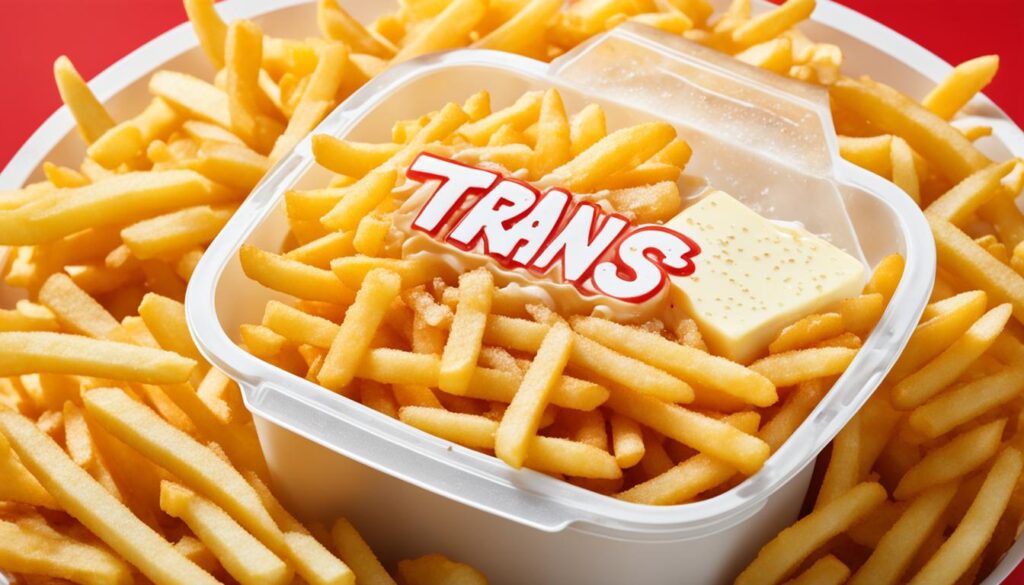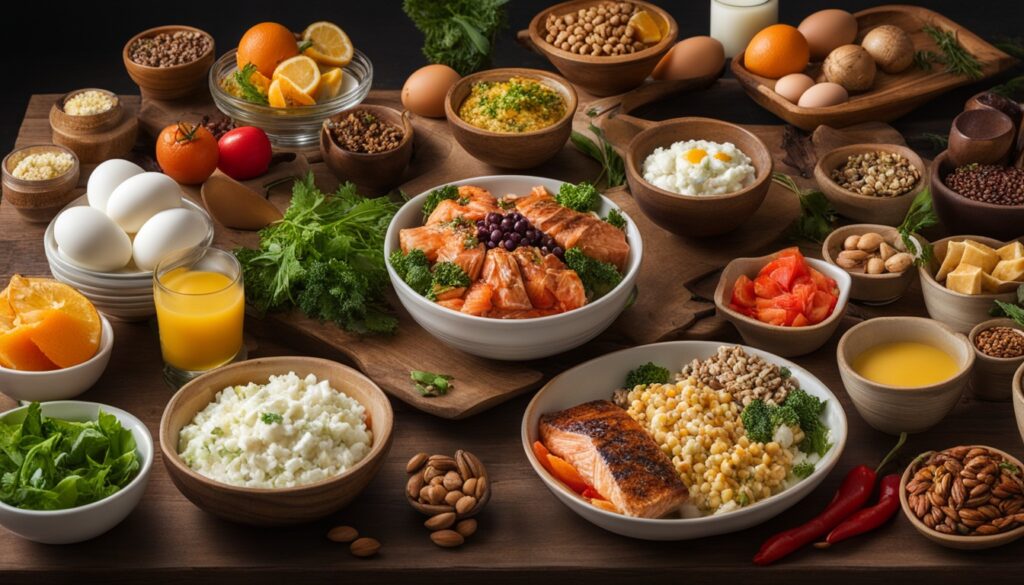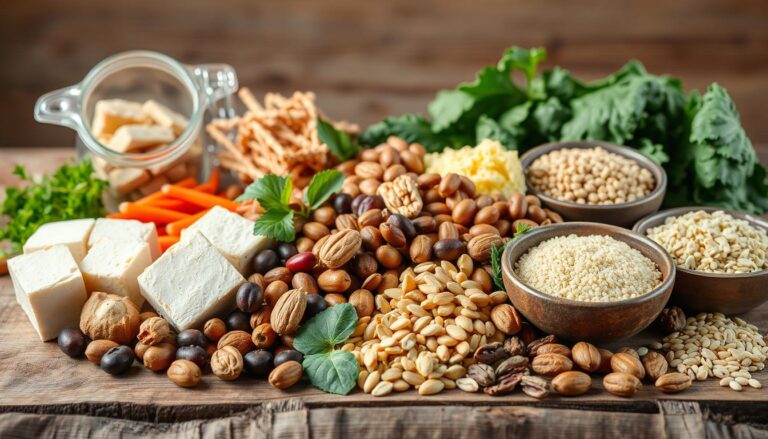Are you tired of the stubborn belly fat that clings to your midsection, despite your best efforts?
You’re not alone. Excess belly fat also known as visceral fat, can be a frustratingly persistent issue. But there are effective strategies backed by science to help you fight back.
In this article, we’ll explore the most evidence based approaches to shedding that stubborn belly fat. We’ll help you reclaim a healthier more confident you.
Key Takeaways
- Larger waistlines are linked to a higher risk of heart disease, diabetes, and cancer1
- A low-carb diet can lead to 10 pounds more weight loss compared to a low-fat diet1
- Regular physical activity helps burn abdominal fat, with 30-60 minutes of moderate to vigorous exercise recommended1
- Reducing stress and limiting sugar and refined carb intake are crucial for tackling belly fat
- Combining strength training and aerobic exercise is most effective for visceral fat reduction
Soluble Fiber for Belly Fat Loss
Adding more soluble fiber to your diet can help fight belly fat. Soluble fiber absorbs water and forms a gel in your gut. This slows down digestion and makes you feel full2. This can lead to eating fewer calories and losing weight.
Research shows that eating more soluble fiber can lower the risk of gaining belly fat by 3.7% over five years. People who eat more soluble fiber also tend to have less visceral fat. This type of fat is around the organs and is linked to health issues. The fermentation of soluble fiber produces short-chain fatty acids, which might help with this.
Having a diverse gut bacteria, often from eating more soluble fiber, is also linked to less belly fat2. This shows how important gut health is for managing weight and fat distribution.
Soluble Fiber Sources and Recommendations
Good sources of soluble fiber are fruits, veggies, legumes, oats, and barley. Men should aim for 30–38 grams of fiber a day, and women should aim for 21–25 grams. If diet alone doesn’t give you enough fiber, supplements like psyllium husk, glucomannan, and inulin can help with belly fat.
Soluble fiber acts as a natural appetite suppressant, reducing calorie intake and aiding in weight loss.
Adding soluble fiber to your daily life can be a key move for losing belly fat and boosting health. It slows digestion increases fullness, and supports a healthy gut. Soluble fiber is a strong tool for your weight loss goals.

Limit Trans Fats to Reduce Belly Fat
Shedding stubborn belly fat starts with cutting down on trans fats. These fats are bad for your health, causing inflammation, insulin resistance, and more belly fat. Thanks to the U.S. Food and Drug Administration, trans fats are less common now. But, they’re still in many fried, packaged, or processed foods.
Reading labels is key to avoiding trans fats. Watch for partially hydrogenated on the label, which means trans fats are present. Switching to foods full of good fats can help lower your trans fat intake.
- Trans fats can raise bad cholesterol and lower good cholesterol, upping the risk of heart disease and stroke.
- These fats have 9 calories per gram, which can lead to weight gain and increase diabetes and heart disease risk.
- The 2020-2025 Dietary Guidelines suggest eating less than 10% of your daily calories from saturated fats and choosing foods with no trans fat.
By watching your trans fat intake and choosing healthier options, you can cut down belly fat and boost your health.

Replacing foods high in trans and saturated fats with healthier options rich in polyunsaturated and monounsaturated fats is recommended for reducing trans fat intake.
| Nutrient | Impact on Health |
|---|---|
| Trans Fats | Increase LDL bad cholesterol decrease HDL good cholesterol increase risk of heart disease and stroke |
| Saturated Fats | Increase LDL bad cholesterol increase risk of heart disease |
| Polyunsaturated Fats | Reduce LDL bad cholesterol increase HDL good cholesterol reduce risk of heart disease |
| Monounsaturated Fats | Reduce LDL bad cholesterol increase HDL good cholesterol reduce risk of heart disease |
Moderate Your Alcohol Intake
Drinking too much alcohol can lead to more belly fat. The NIAAA says heavy drinking is more than three drinks a day or seven a week for women. For men, it’s more than four drinks a day or 14 a week6. But drinking in moderation doesn’t always mean you’ll gain weight.
Cocktails and mixed drinks usually have more calories than beer or wine. A piña colada can have up to 500 calories in a seven-ounce serving. Alcohol can make you feel sleepy but too much can hurt your sleep quality. It can also lower your blood sugar making you hungrier, especially for carbs6.
Drinking too much can make you gain weight over time. It can make you eat more because of hormones that control hunger and stress. Men are more likely to get belly fat from drinking than women. To stay healthy and keep belly fat away limit your drinking to two drinks a day for men and one for women, as advised by the Dietary Guidelines for Americans.

Excess alcohol consumption has been linked to increased belly fat accumulation.
| Alcoholic Beverage | Calories per Serving |
|---|---|
| Beer 12 oz can | 155 calories |
| Red Wine 5 oz glass | 125 calories |
| Vodka 1.5 oz, 80-proof | 100 calories |
| Whiskey 1.5 oz, 86-proof | 100 calories |
| Gin 1.5 oz, 90-proof | 115 calories |
| Tequila 1.5 oz | 100 calories |
| Brandy 1.5 oz | 100 calories |
Eat a High Protein Diet
Eating a diet high in protein can help you lose belly fat. Protein makes you feel full by releasing the hormone peptide YY, which helps you eat less9. Studies show that eating more protein is linked to less belly fat.
Choose high-quality protein sources like lean meats fish eggs dairy whey protein, and legumes. Aim for 50 grams of protein and 30 grams of fiber a day for best results. A large egg has 7 grams of protein, and a cup of kefir or Greek yogurt gives you 10 to 20 grams. Chickpeas and peanuts are great too, with 7 and 9 grams of protein per half-cup. A 3.5-ounce cooked chicken has 31 grams of protein.
High-protein diets can lead to more weight loss and less belly fat without cutting calories or eating less. They help you burn more calories and keep muscle mass while losing weight which boosts your metabolism. Try to get 25-35% of your calories from protein to help lose belly fat. Adding protein supplements like whey powder can also help meet your protein needs.

Eating a high-protein diet is a powerful way to support weight loss and reduce belly fat. It helps keep you feeling full and satisfied, while also boosting your metabolism.
| Meal Plan | Calories | Protein g | Carbs g | Fiber g | Fat g | Sat. Fat g |
|---|---|---|---|---|---|---|
| Plan 1 | 1,208 | 90 | 127 | 30 | 42 | 13 |
| Plan 2 | 1,219 | 76 | 141 | 31 | 43 | 10 |
| Plan 3 | 1,222 | 70 | 143 | 30 | 45 | 9 |
The meal plans offer 1,193 to 1,224 calories a day, focusing on protein and fiber for weight loss and belly fat reduction. A 5-ounce container of nonfat plain Greek yogurt has about 69 grams of protein.
Reduce Stress Levels
Stress can make you gain weight, especially around your midsection. When stressed your body makes more cortisol the stress hormone. This hormone is linked to belly fat, as shown in a 2018 study. High cortisol levels can cause weight gain, mainly in the belly.
Studies show that too much cortisol leads to belly fat and bigger waist sizes. Signs of too much cortisol include gaining weight in the face and belly, getting stretch marks, high blood pressure, and feeling very tired.
Stress can stop you from losing belly fat and raises the risk of other health issues like headaches and anxiety. Too much belly fat can increase the risk of many diseases including heart disease and cancer says Harvard Health.
Try to lose one to two pounds of fat each week for a healthy goal. Sleeping 7 to 9 hours a night and exercising for 30 minutes four times a week can help. Also eating foods like green leafy veggies bananas, and avocados can help with stress.
Techniques like meditation and deep breathing can keep cortisol levels in check. Keeping a healthy weight staying active, and eating well are key for managing stress and staying healthy.

Limit Sugary Foods
Too much sugar, especially from added sugars and refined carbs, leads to weight gain and belly fat. Americans eat 22 to 28 teaspoons of added sugars daily way more than the recommended 6.5 teaspoons for women and 9.5 teaspoons for men. Drinking sugar-sweetened beverages can make women gain up to 10 pounds.
It’s not just about added sugars. Foods like white bread and pasta, which are high in refined carbs, can also lead to belly fat. Research shows that fructose, found in sugars and fruits, might increase belly fat and insulin resistance. Teenagers eating a lot of fructose tend to have more belly fat and insulin issues.
To manage belly fat, cut down on sugary foods and drinks, and refined carbs. Eat whole, unprocessed foods and watch out for hidden sugars in your diet. Experts say to keep free sugar intake under 30g 1oz a day, but most people eat more.
Aerobic Exercise for Belly Fat
Aerobic exercise, or cardio, is a great way to boost your health and burn calories including belly fat. Studies show it helps cut down belly and liver fat. High intensity interval training HIIT exercises are also good for weight control and getting in shape.
To lose weight and reduce fat aim for 225-420 minutes of moderate to vigorous exercise each week. This can be brisk walking, jogging, cycling, or swimming. Doing aerobic exercises with a healthy diet is the best way to lose belly fat and body fat.
Adding weight training can also help with belly fat. It builds lean muscle, lowers fat, and speeds up metabolism. Try a HIIT routine with 30 seconds of intense activity followed by 30 seconds of rest.
For working on the lower abs, start with 15 to 20 reps of mountain climbers. Lying leg raises in 10 to 15 reps are also good. A standard crunch should have 12 to 20 reps for both upper and lower abs. Toe touches are great for a tough lower ab workout.
But be careful not to overtrain, as it can increase cortisol and slow down belly fat loss. Stress and poor sleep can also affect fat loss by changing cortisol levels and appetite. Activities like mindfulness breathing exercises, and gentle exercises like tai chi and yoga can help with stress and sleep.
Remember combining regular aerobic exercise, strength training, and a healthy lifestyle is the best way to reduce stubborn belly fat and meet your weight loss goals.
Cut Back on Refined Carbs
Reducing your intake of refined carbohydrates can really help in losing belly fat. Studies show that eating fewer refined carbs and choosing whole grains, legumes, and veggies can boost your metabolic health and cut down on belly fat.
The Framingham Heart Study found that eating more whole grains made people 17% less likely to have too much abdominal fat than those eating lots of refined grains.
- Very low-carb diets limit carbs to less than 10% of your diet, which is 20 to 50 grams a day.
- Low-carb diets focus on less than 26% carbs, or about 130 grams a day.
- It usually takes 2 to 3 weeks to start burning fat and get into ketosis by eating fewer refined carbs.
By picking whole grains over refined carbs, you can greatly reduce belly fat and better your metabolic health.
Excess sugar intake, especially from added sugars and refined carbs, leads to weight gain and belly fat
Conclusion
Losing stubborn belly fat is tough but it’s doable with the right mix of nutrition, exercise, and lifestyle changes. This article shared tips like eating more soluble fiber cutting down on trans fats and refined carbs, and drinking less alcohol. It also talked about the benefits of a high protein diet managing stress, and doing both aerobic and resistance exercises.
The SHAPE-2 study showed that 243 postmenopausal overweight women lost belly fat by following diet and exercise plans. The diet and exercise groups both saw big fat reductions, but exercise added more to the diet group’s results. Studies also stress the need to target belly fat because it’s linked to heart disease and type 2 diabetes.
By using these proven methods, people can manage their weight loss and get rid of stubborn belly fat. Remember, being consistent and patient is crucial. Stick with it and enjoy the perks of a healthier, more toned midsection.





